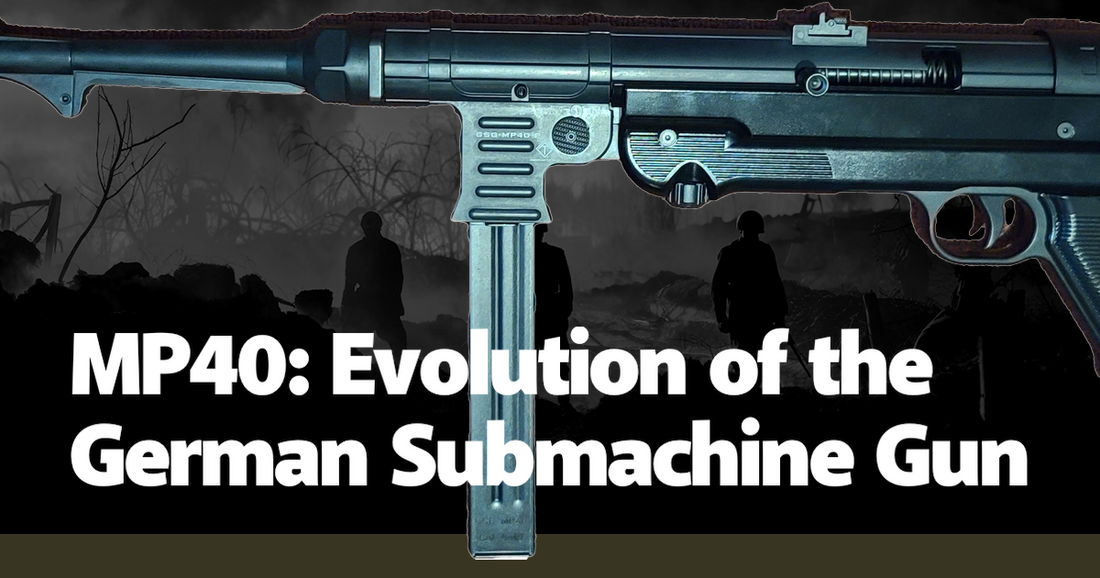The MP40, a submachine gun synonymous with the German Wehrmacht during World War II, represents a significant evolution in firearm design and military strategy. Its origins trace back to the MP38, developed in the late 1930s by Heinrich Vollmer. The MP38 was revolutionary in its own right, featuring a folding stock and a simplified construction utilizing stamped steel parts, which was a departure from the intricate machining processes of earlier firearms. This design ethos aimed at mass production would become even more pronounced in its successor, the MP40, which saw extensive use from 1940 onwards. The MP40’s development was driven by the need for a reliable, easy-to-manufacture weapon that could be produced in large quantities to arm the rapidly expanding German military forces.
The MP40’s design was a marvel of wartime engineering, balancing simplicity and effectiveness. It featured a blowback-operated, open-bolt system, which allowed for fewer moving parts and greater reliability in the field. The 32-round detachable box magazine provided ample firepower, though it was not without its flaws; soldiers often found it prone to jamming if not properly maintained. The weapon’s rate of fire, approximately 500-550 rounds per minute, was slower than some of its contemporaries, but this was a deliberate choice to enhance control and accuracy during sustained fire. The MP40’s effective range was around 100-200 meters, making it ideal for close-quarters combat, urban warfare, and the varied terrains of the Eastern and Western Fronts.
One of the most distinctive features of the MP40 was its ergonomic design. The weapon’s folding metal stock allowed for compact storage and ease of transport, crucial for paratroopers and mechanized infantry. The grip was designed to be comfortable and intuitive, reducing fatigue during prolonged engagements. Anecdotal evidence from veterans often highlights the MP40’s user-friendly nature; soldiers appreciated its balance and handling, which contrasted sharply with the heavier, more cumbersome rifles of the era. This ergonomic advantage was not just a matter of comfort but a tactical edge, allowing soldiers to react swiftly and effectively in the chaos of battle.
The MP40’s impact on infantry tactics cannot be overstated. Before its widespread adoption, the German military primarily relied on bolt-action rifles like the Karabiner 98k, which, while accurate, were limited by their rate of fire. The introduction of the MP40 allowed for a shift towards more mobile, aggressive tactics. Squads equipped with MP40s could lay down a continuous stream of suppressive fire, enabling rapid advances and flanking maneuvers. This was particularly evident in the Blitzkrieg campaigns, where speed and shock were paramount. The MP40 became a symbol of this new form of warfare, embodying the principles of mobility and firepower.
Despite its advantages, the MP40 was not without its limitations. The reliance on stamped steel parts, while beneficial for mass production, resulted in a weapon that could be less robust than its machined counterparts. The open-bolt design, while reliable, also made the weapon more susceptible to dirt and debris, which could cause malfunctions in harsh conditions. Additionally, the 9mm Parabellum cartridge, while effective at close range, lacked the stopping power and range of larger rifle calibers. These limitations were acknowledged by the German military, which continued to develop and field other firearms to complement the MP40.
The legacy of the MP40 extends beyond its immediate wartime use. Its influence can be seen in the design of post-war submachine guns and assault rifles. The concept of a lightweight, easily manufactured weapon with a high rate of fire and ergonomic design became a standard for future military small arms. The Soviet PPS and the American M3 "Grease Gun" are examples of firearms that drew inspiration from the MP40’s design principles. Even modern submachine guns, such as the Uzi and the MP5, owe a debt to the innovations pioneered by the MP40.
In popular culture, the MP40 has achieved an iconic status, often depicted in films, video games, and literature as the quintessential German weapon of World War II. This portrayal, while sometimes romanticized, underscores the weapon’s historical significance and the impression it left on those who encountered it. Veterans’ accounts and historical analyses frequently highlight the MP40’s role in shaping the dynamics of infantry combat during the war. Its distinctive silhouette and the sound of its firing have become ingrained in the collective memory of the conflict.
The MP40 remains a subject of fascination for historians, collectors, and military enthusiasts. Its design, production, and battlefield performance offer rich insights into the technological and tactical developments of World War II. As a symbol of innovation and adaptation, the MP40 encapsulates the relentless drive for efficiency and effectiveness that characterized wartime engineering. Its story is not just one of a weapon but of the men who carried it, the battles they fought, and the strategies they employed. The MP40’s evolution reflects the broader narrative of a world at war, where necessity drove innovation and where every advantage, no matter how small, could tip the balance in the struggle for victory.

